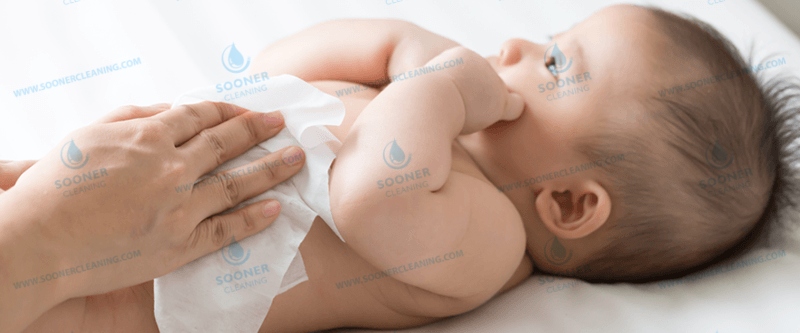Home>News
What are the hazards of wet wipes raw materials? To produce safe wet wipes products
- 2024-09-03
According to market research, wet wipes base fabric spunlace non-woven fabric is the main factor that determines the effect of wet wipes and ultimately affects consumers' purchase and use. The performance evaluation of wet wipes base materials by manufacturers includes basic performance (surface density, thickness, porosity and mechanical properties), comfort (breathability, moisture permeability and softness), and functionality (liquid carrying rate, permeability, water retention rate and antibacterial properties), while there is very little research on toxic and harmful substances that may exist in wet wipes base non-woven fabrics, and safety considerations are almost ignored.
So, where are the safety risks of spunlace non-woven fabrics, the raw materials of wet wipes, roughly from?
1. Residual toxic and harmful substances in the raw materials of wet wipes base fabrics
In addition to natural fibers such as cotton fibers, organic solvents or heavy metal ion aqueous solutions are used in the production and processing of non-natural fibers such as regenerated cellulose fibers commonly used in wet wipes base fabrics. Therefore, a small amount of toxic and harmful substances that are irritating to the skin may remain in the raw materials of spunlace base fabrics.
2. Chemical additive pollution during wet wipe production process
In the spunlace production process of wet wipe substrate, chemical additives such as softeners, stiffeners, hydrophilic agents, finishing additives, antistatic agents, whitening agents, penetrants, special bactericides for spunlace, spunlace needle plate cleaning agents, defoaming agents, etc. can be added according to actual needs. They are often used to improve the stability of wet wipe base fabrics and facial mask base fabrics in the production process and improve product quality. Therefore, it is necessary to clarify the relationship between the type and equivalent of added chemical additives and the degree of pollution of wet wipe base fabrics and facial mask base fabrics.
3. Accelerate the exudation and migration of toxic and harmful substances during circulation and storage
Wet wipes and facial masks contain a variety of oily ingredients such as moisturizers, thickeners, emulsifiers, preservatives, and flavors and fragrances. They are weakly acidic and have a shelf life of 2 to 3 years. During long-term storage, it may accelerate the exudation and migration of toxic and harmful substances and chemical additives in the mask base fabric, which will have a certain impact on the safety of mask use.
4. Plastic pollution to the environment
Many wet wipes raw materials contain plastic fibers (such as polyester), which are not easy to degrade and cause long-term pollution to the environment. They may accumulate in the environment, forming microplastics, which have a negative impact on ecosystems and organisms.
Due to the large differences in the inspection capabilities of raw and auxiliary materials and the control of added substances among wet wipes manufacturers, especially in the selection and quality control of wet wipes substrates, there is a situation where the impact on product quality is underestimated, resulting in uneven quality of wet wipes products, insufficient evaluation of product safety and efficacy, and unstable quality of wet wipes products, which brings safety hazards to consumers.
The risk of wet wipes substrate spunlace non-woven fabrics causing health hazards to consumers should be fully taken seriously by wet wipes manufacturers. Wet wipes companies can improve the raw material supervision system from the following aspects:
1. Improve testing specifications:
Quality inspection is of great significance to the control of product quality and safety. According to the characteristics of wet wipes products, establish testing specifications that meet the characteristics of the products, clarify the important sources and main influencing factors of wet wipes substrate safety risks, and lay a good foundation for the establishment of relevant testing methods.
At present, the testing indicators of wet wipes products are only required according to conventional testing methods, such as pH, microorganisms, heavy metals, etc., but there are no clear regulations on the inspection standards and specifications of important raw materials, spunlace non-woven fabrics. Wet wipes companies should have a detailed technical parameter quality inspection guidance. When quality inspectors conduct quality inspections, they can help wet wipes manufacturers standardize product quality, ensure product safety, and provide consumers with safe and reliable wet wipes products through unified wet wipes quality guidelines.
2. Select spunlace non-woven fabric raw material suppliers according to certifications and standards:
Check whether the supplier meets international certifications, such as ISO9001, ISO14001; require suppliers to provide product safety test reports to understand whether the raw materials used by the supplier meet environmental standards and health and safety requirements. Choose spunlace non-woven fabric suppliers that use advanced and transparent production processes to reduce potential pollution or harmful ingredients. You can also understand the supplier's reputation and service quality by visiting the factory on site and checking other customers' feedback and evaluations.
Therefore, it is of great significance for wet wipes companies to conduct a survey of the current wet wipes carrier materials in the market and establish scientific inspection guidelines or standards in order to ensure consumer requirements and promote high-quality product development.




